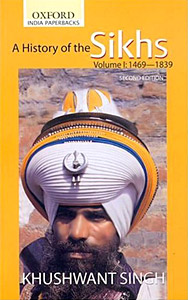 This book History of Sikhs - 2 Volumes by the author Khushwant Singh remains the most comprehensive and authoritative book on the Sikhs. Though the book is based on scholarly archival research it can also be read by common non-scholarly audience. This book also carries the author`s patent style for which he is famous.
This book History of Sikhs - 2 Volumes by the author Khushwant Singh remains the most comprehensive and authoritative book on the Sikhs. Though the book is based on scholarly archival research it can also be read by common non-scholarly audience. This book also carries the author`s patent style for which he is famous.
Khushwant Singh is an awesome writer writing numerous fiction and non-fiction and many other novels. He is best selling author of over 80 books and two weekly columns syndicated in over 40 English publications. In the year 1999, when Sikhs celebrated 300th year of Khalsa at Anandpur sahib. It is estimated that about eight million people visited the city at the time. To the delight of million of Sikhs, he was honored with `Order of Khalsa` or Nishaan-e-Khalsa, the highest decorum bestowed upon by the Sikhs community. Khushwant Singh was awarded the Padam Bhushan in 1974. Ten years later in 1984, he returned the honor as protest to Government of India against the storming of Golden Temple by the Army. On June 8, a day after the incident, he drove to Rashtrapati Bhavan and returned the framed citation to the President of India, Giani Zail Singh, who himself was a Sikh. It was an act of Courage. People from different parts of the country contacted him about the matter, to know the details of the damage to Golden Temple. It also saw his falling out with Nehru family. Khushwant Singh was Member of Parliament, Rajya Sabha, from 1980 to 1986. He used to speak direct what he feels. In July 2000, Khushwant received Sulabh Award for `upholding moral values and being a person of impeccable character and exceptional integrity`. Andhra Pradesh Chief minister Chandrababu gave away the award. The function was marked by the release of a book on life of the worthy recipient called `Khushwant Singh: An Icon of our Age`. To the delight of thousands of Khushwant followers, External affairs minister Jaswant Siingh released the book. This book is a collection of article by the writers of varied backgrounds including IFS Pavan Verma, Solicitor General Soli Sorabjee and Dr Bindeshwar Pathak, the founder of Sulabh International for Social Service.
Synopsis:
History of Sikhs - 2 Volumes by Khushwant Singh covers the social, religious and political background, which led to the formation of the Sikh faith in the fifteenth century. Basing his account on original documents in Persian, Gurmukhi and English, the author traces the growth of Sikhism and tells of the compilation of its sacred scriptures in the Granth Sahib. The transformation of the Sikhs from a pacifist sect to a militant group called the Khasla led by Guru Gobind Singh is portrayed in detail, as is the relationship of the Sikhs with the Mughals and the Afghans, until the consolidation of Sikh power under Maharaja Ranjit Singh. This creation of Khushwant Singh is critically acclaimed throughout the world.
The Oxford University Press publishes `History of Sikhs - 2 Volumes` by Khushwant Singh.













